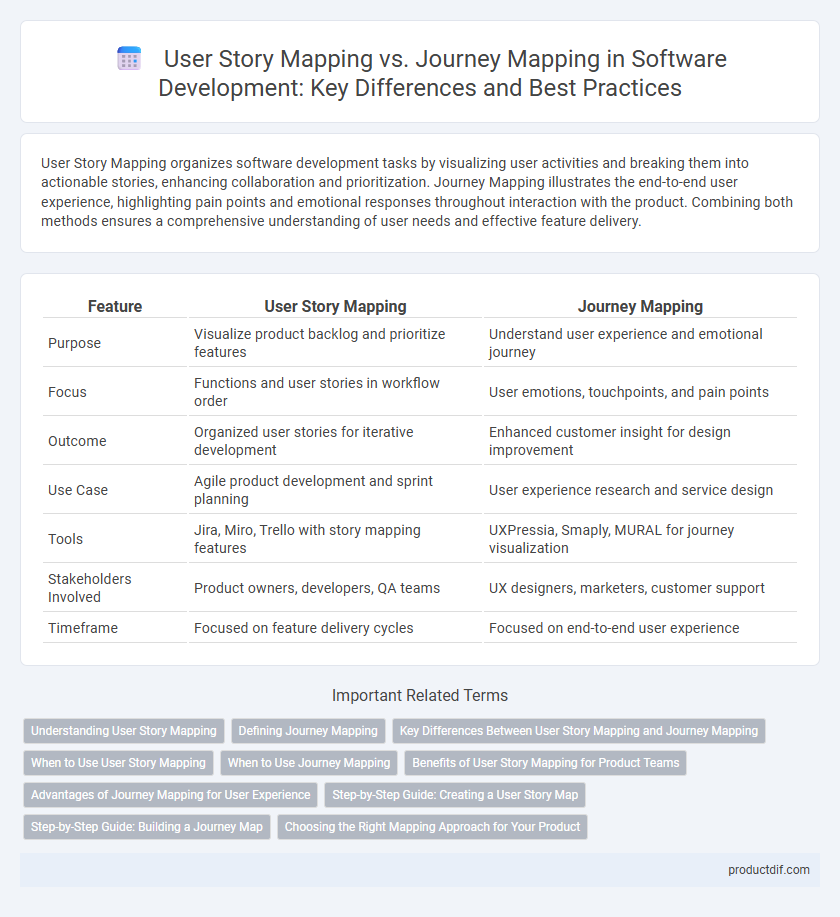User Story Mapping organizes software development tasks by visualizing user activities and breaking them into actionable stories, enhancing collaboration and prioritization. Journey Mapping illustrates the end-to-end user experience, highlighting pain points and emotional responses throughout interaction with the product. Combining both methods ensures a comprehensive understanding of user needs and effective feature delivery.
Table of Comparison
| Feature | User Story Mapping | Journey Mapping |
|---|---|---|
| Purpose | Visualize product backlog and prioritize features | Understand user experience and emotional journey |
| Focus | Functions and user stories in workflow order | User emotions, touchpoints, and pain points |
| Outcome | Organized user stories for iterative development | Enhanced customer insight for design improvement |
| Use Case | Agile product development and sprint planning | User experience research and service design |
| Tools | Jira, Miro, Trello with story mapping features | UXPressia, Smaply, MURAL for journey visualization |
| Stakeholders Involved | Product owners, developers, QA teams | UX designers, marketers, customer support |
| Timeframe | Focused on feature delivery cycles | Focused on end-to-end user experience |
Understanding User Story Mapping
User Story Mapping organizes product backlog items visually to prioritize features based on user goals and workflows, enhancing collaboration between development teams and stakeholders. It breaks down complex functionalities into manageable tasks aligned with user needs, promoting iterative development and delivering value incrementally. This technique is essential for maintaining a clear product vision while adapting to evolving requirements in Agile software projects.
Defining Journey Mapping
Journey Mapping is a strategic process that visualizes the end-to-end user experience by outlining each interaction point between the user and the product or service. It captures emotional states, user goals, and pain points across different stages to identify opportunities for improving customer satisfaction and engagement. This method provides a holistic view that aligns cross-functional teams with a user-centered approach to product development.
Key Differences Between User Story Mapping and Journey Mapping
User Story Mapping organizes product features into a visual flow that highlights user tasks and prioritizes development based on user needs, while Journey Mapping focuses on the emotional and experiential aspects of a user interacting with a product or service over time. User Story Mapping emphasizes task completion and collaboration within Agile teams to create actionable backlogs, whereas Journey Mapping provides a holistic view of user motivations, pain points, and touchpoints across multiple channels. The primary difference lies in User Story Mapping's detailed task breakdown for developers versus Journey Mapping's broader perspective on user experience and satisfaction.
When to Use User Story Mapping
User Story Mapping is most effective during the product development phase when teams need to break down complex features into manageable user stories for agile workflows. It helps prioritize tasks by visualizing the user's interactions with the product step-by-step, ensuring alignment with user goals and project milestones. Use User Story Mapping when clear task prioritization and iterative delivery are essential for maintaining an adaptive development process.
When to Use Journey Mapping
Use Journey Mapping when the goal is to understand the end-to-end customer experience across multiple touchpoints and channels, uncovering pain points and emotional responses at each stage. It is ideal for identifying opportunities for process improvement and aligning team efforts around holistic customer goals. This approach excels in complex systems where user interactions span various departments or platforms, providing a comprehensive view of user behavior over time.
Benefits of User Story Mapping for Product Teams
User Story Mapping enhances product teams' collaboration by visually organizing user stories along user activities, enabling clearer prioritization and efficient backlog management. This approach fosters shared understanding of user needs and product goals, leading to focused development efforts and faster delivery of valuable features. By aligning tasks with user workflows, teams improve communication, reduce scope creep, and ensure the product evolves based on real user priorities.
Advantages of Journey Mapping for User Experience
Journey mapping enhances user experience by providing a holistic view of the customer's interactions across multiple touchpoints, enabling identification of pain points and opportunities for improvement. It facilitates empathy by illustrating the user's emotions and motivations throughout the process, allowing for more user-centered design decisions. This approach supports cross-functional collaboration by aligning teams around a shared understanding of the user journey, leading to more cohesive and satisfying experiences.
Step-by-Step Guide: Creating a User Story Map
Creating a User Story Map involves breaking down product features into user tasks and organizing them sequentially to visualize the user's workflow and prioritize development. Begin by identifying user personas, then list all user activities and group related tasks under each activity in a horizontal layout, with the stories arranged vertically to show priority and detail. This step-by-step approach enhances collaboration, ensures alignment with user needs, and streamlines backlog management compared to journey mapping, which focuses more on emotional touchpoints throughout the user's experience.
Step-by-Step Guide: Building a Journey Map
Building a journey map involves identifying user personas, mapping out their interactions step-by-step, and highlighting pain points and emotions throughout the experience. This process creates a visual representation of the user's experience, enabling teams to uncover opportunities for improvement and design better solutions. Compared to user story mapping, journey mapping offers a broader view of the entire user experience, focusing on emotions and motivations across all touchpoints.
Choosing the Right Mapping Approach for Your Product
User Story Mapping emphasizes feature prioritization by breaking down product functionality into user tasks, enabling agile teams to focus on delivering value incrementally. Journey Mapping captures the comprehensive user experience across touchpoints, revealing emotional highs and lows critical for identifying pain points and opportunities for improvement. Selecting the optimal mapping approach depends on whether the goal is to refine development workflows or to enhance holistic user experience, ensuring alignment with product objectives and stakeholder needs.
User Story Mapping vs Journey Mapping Infographic

 productdif.com
productdif.com